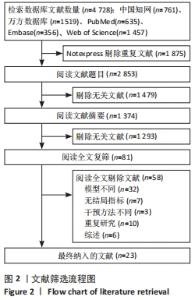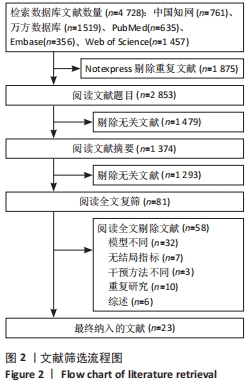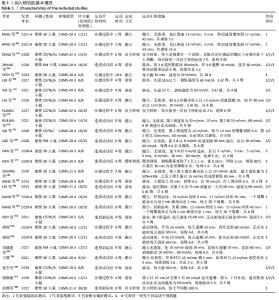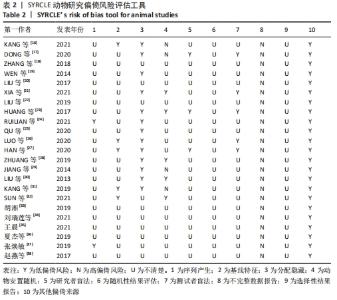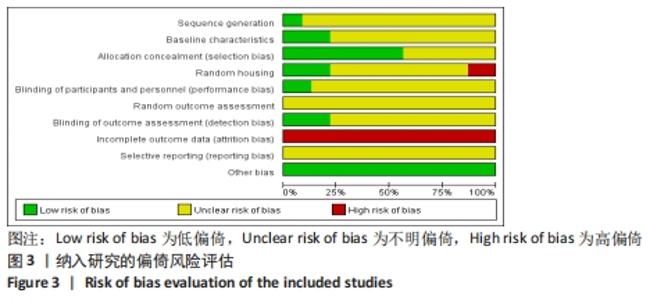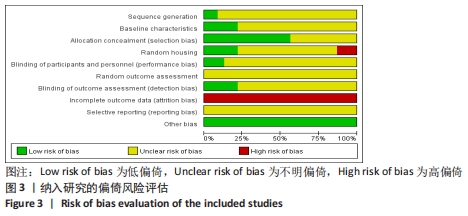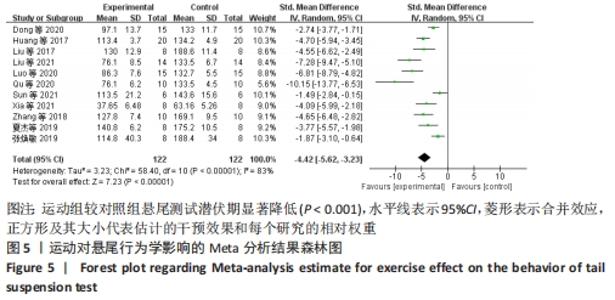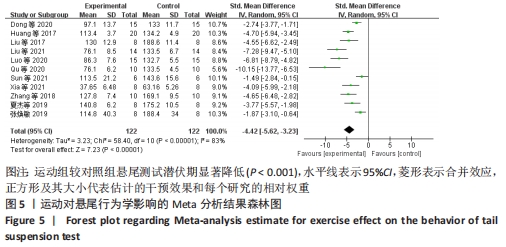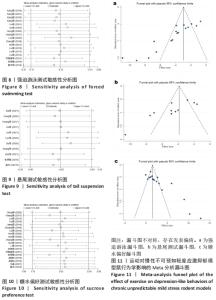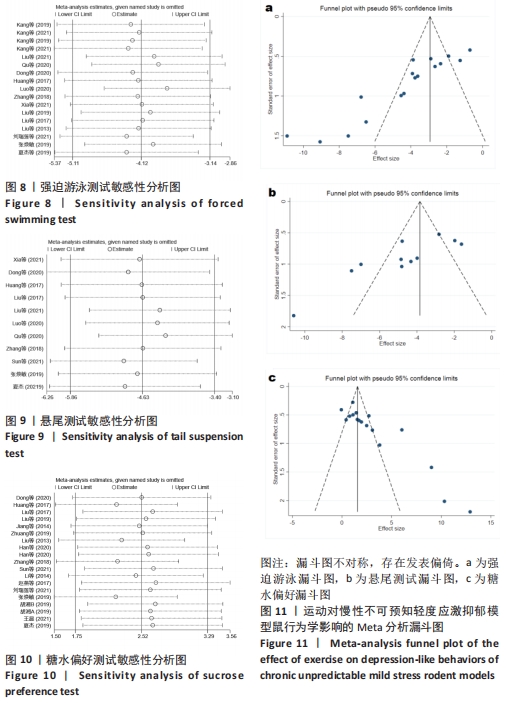Chinese Journal of Tissue Engineering Research ›› 2023, Vol. 27 ›› Issue (5): 813-820.doi: 10.12307/2023.069
Effects of exercise on depression-like behaviors in chronic unpredictable mild stress rodent models: a systematic review and Meta-analysis
Wang Xiaoge1, 2, Liu Jiwen3, Yang Shuai1, 2, Bao Jinyu1, Li Cui1, 2, 4
- 1School of Physical Education (Main Campus), 2Institute of Neuroscience, 3School of Mechanical and Power Engineering, 4School of Basic Medical Sciences, Zhengzhou University, Zhengzhou 450001, Henan Province, China
-
Received:2022-01-26Accepted:2022-04-24Online:2023-02-18Published:2022-07-25 -
Contact:Li Cui, Ph D, Lecturer, School of Physical Education (Main Campus), Zhengzhou University, Zhengzhou 450001, Henan Province, China; Institute of Neuroscience, Zhengzhou University, Zhengzhou 450001, Henan Province, China; School of Basic Medical Sciences, Zhengzhou University, Zhengzhou 450001, Henan Province, China -
About author:Wang Xiaoge, Master candidate, School of Physical Education (Main Campus), Zhengzhou University, Zhengzhou 450001, Henan Province, China -
Supported by:Special Start-up Fund for Outstanding Young Teachers of Zhengzhou University, No. 32211505 (to LC); Henan Provincial Postdoctoral Research Project, No. 202002002 (to LC); National College Students Innovation and Entrepreneurship Training Program, No. 202110459139 (to BJY)
CLC Number:
Cite this article
Wang Xiaoge, Liu Jiwen, Yang Shuai, Bao Jinyu, Li Cui. Effects of exercise on depression-like behaviors in chronic unpredictable mild stress rodent models: a systematic review and Meta-analysis[J]. Chinese Journal of Tissue Engineering Research, 2023, 27(5): 813-820.
share this article
Add to citation manager EndNote|Reference Manager|ProCite|BibTeX|RefWorks
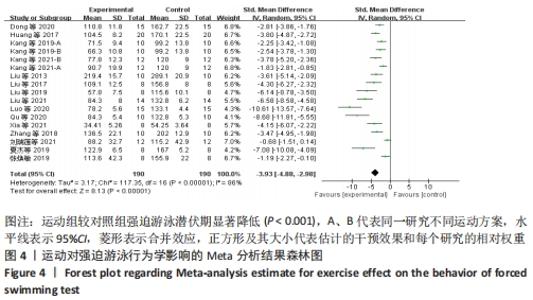
2.4 Meta分析结果 2.4.1 运动对强迫游泳行为学影响的Meta分析结果 观察运动对强迫游泳行为学结果的影响,共纳入15篇文献[16-18,20-26,30-31,34,36-37],其中2篇文献包含2种运动方案[16,31],共17个研究。Meta分析结果显示,此17个研究存在较大的异质性,采用随机效应模型,合并效应量[SMD=-3.93,95%CI:(-4.88,-2.98),P < 0.000 01],见图4,表明运动干预可以改善CUMS抑郁模型鼠强迫游泳测试潜伏期。为了探讨异质性来源,对干预阶段、运动时间、运动方式和造模时间进行回归分析,见表3,探索可能的异质性来源。回归分析结果显示干预阶段、运动时间,运动方式和造模时间对研究间的异质性均没有显著影响。"
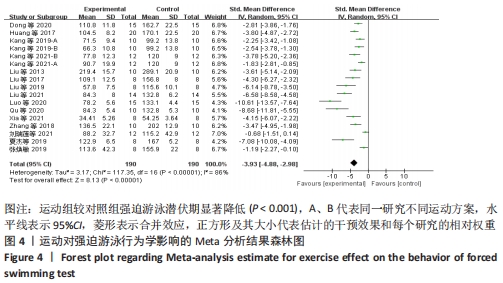
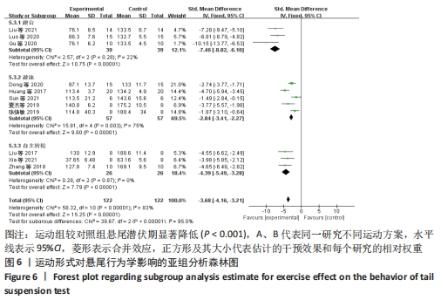
根据运动方式不同对悬尾测试行为学进行亚组分析,结果显示:无论是跑台、游泳还是自主转轮,运动组悬尾测试的潜伏期都显著低于对照组,见图6。对运动方式的亚组分析显示,跑台运动使悬尾测试潜伏期显著降低,与对照组比较有显著性意义[SMD=-7.46,95%CI:(-8.82,-6.10),P < 0.000 01],组内异质性检验I2=22%,异质性风险较低;游泳运动使悬尾测试潜伏期显著降低,差异具有统计学意义[SMD=-2.84,95%CI:(-3.41,-2.27),P < 0.000 01],组内异质性检验I2=75%,异质性风险较高;自主转轮运动使悬尾测试潜伏期显著降低,亦具有显著性差异[SMD=-4.39,95%CI:(-5.49,-3.28),P < 0.000 01],组内异质性检验I2=0%,无异质性风险。 "
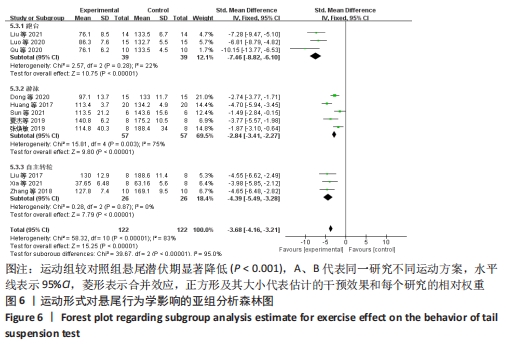

2.4.3 运动对糖水偏好测试行为学影响的Meta分析结果 观察运动对糖水偏好测试行为学结果的影响共纳入17篇文献[17-20,22-23,27-30,32-38],其中2篇文献包含2种运动方案[27,33],共19个研究。Meta分析结果显示,此19个研究存在较大的异质性,采用随机效应模型,合并效应量[SMD=2.37,95%CI:(1.62,3.11),P < 0.000 01],表明运动干预可以改善CUMS抑郁模型鼠糖水偏好测试行为学的结果,见图7。鉴于运动对糖水测试行为学结果的研究间存在较大的异质性,根据纳入文献基本情况推测可能与造模时间、干预阶段、运动方式及运动时间等因素有关。为此,文章将上述因素作为协变量进行Meta 回归分析,探索可能的异质性来源。结果显示,造模时间、干预阶段、运动方式及运动时间对研究间的异质性无显著影响,见表5。"

| [1] GBD 2019 Mental Disorders Collaborators. Global, regional, and national burden of 12 mental disorders in 204 countries and territories, 1990-2019: a systematic analysis for the Global Burden of Disease Study 2019. Lancet Psychiatry. 2022;9(2):137-150. [2] BOSAIPO NB, FOSS MP, YOUNG AH, et al. Neuropsychological changes in melancholic and atypical depression: A systematic. Neurosci Biobehav Rev. 2017;73:309-325. [3] AKIL H, GORDON J, HEN R, et al. Treatment resistant depression: A multi-scale, systems biology approach. Neurosci Biobehav Rev. 2018;84:272-288. [4] WANG S, HAN C, BAHK W, et al. Addressing the Side Effects of Contemporary Antidepressant Drugs: A Comprehensive Review. Chonnam Med J. 2018;54(2):101-112. [5] 朱冉旭.运动疗法治疗抑郁症的研究进展[J].医学理论与实践,2019,32(21):3433-3434. [6] GUJRAL S, AIZENSTEIN H, REYNOLDS C F R, et al. Exercise effects on depression: Possible neural mechanisms. Gen Hosp Psychiatry. 2017;49:2-10. [7] KVAM S, KLEPPE CL, NORDHUS IH, et al. Exercise as a treatment for depression: A meta-analysis. J Affect Disord. 2016;202:67-86. [8] CAREK PJ, LAIBSTAIN SE, Carek SM. Exercise for the treatment of depression and anxiety. Int J Psychiatry Med. 2011;41(1):15-28. [9] WILLNER P. The chronic mild stress (CMS) model of depression: History, evaluation and usage. Neurobiol Stress. 2017;6:78-93. [10] ANTONIUK S, BIJATA M, PONIMASKIN E, et al. Chronic unpredictable mild stress for modeling depression in rodents: Meta-analysis. Neurosci Biobehav Rev. 2019;99: 101-116. [11] HAO Y, GE H, SUN M, et al. Selecting an Appropriate Animal Model of Depression. Int J Mol Sci. 2019;20(19):4827. [12] YAN H, CAO X, DAS M, et al. Behavioral animal models of depression. Neurosci Bull. 2010;26(4):327-337. [13] STUKALIN Y, LAN A, EINAT H. Revisiting the validity of the mouse tail suspension test: Systematic review and meta-analysis of the effects of prototypic antidepressants. Neurosci Biobehav Rev. 2020;112:39-47. [14] KARA NZ, STUKALIN Y, EINAT H. Revisiting the validity of the mouse forced swim test: Systematic review and meta-analysis of the effects of prototypic antidepressants. Neurosci Biobehav Rev. 2018;84:1-11. [15] HOOIJMANS CR, ROVERS MM, DE VRIES RBM, et al. SYRCLE’s risk of bias tool for animal studies. BMC Med ReS Methodol. 2014;14:43. [16] KANG J, WANG D, DUAN Y, et al. Aerobic Exercise Prevents Depression via Alleviating Hippocampus Injury in Chronic Stressed Depression Rats. Brain Sci. 2021;11(1):9. [17] DONG Z, LIU Z, LIU Y, et al. Physical exercise rectifies CUMS-induced aberrant regional homogeneity in mice accompanied by the adjustment of skeletal muscle PGC-1a/IDO1 signals and hippocampal function. Behav Brain Res. 2020;383:112516. [18] ZHANG Y, CHEN W, MAO H. Intervention of Aerobic Exercise and Lycium ruthenicum Murr Flavone on Mice with Depression and Differential Expression of TLR4/MyD88/NF-kappaB Related Factors. Chinese Journal of Cell Biology. 2018;40:1847-1857. [19] WEN L, JIN Y, LI L, et al. Exercise prevents raphe nucleus mitochondrial overactivity in a rat depression model. Physiol Behav. 2014;132:57-65. [20] LIU W, XUE X, XIA J, et al. Swimming exercise reverses CUMS-induced changes in depression-like behaviors and hippocampal plasticity-related proteins. J Affect Disord. 2017;227:126-135. [21] XIA J, XUE X, LIU W, et al. The Role of Fgf9 in the Antidepressant Effects of Exercise and Fluoxetine in CUMS Mice. Psychosom Med. 2021;83(7):795-804. [22] LIU W, LIU J, HUANG Z, et al. Possible role of GLP-1 in antidepressant effects of metformin and exercise in CUMS mice. J Affect Disord. 2019;246:486-497. [23] HUANG P, HUANG W, ZHOU C, et al. Voluntary wheel running ameliorates depression-like behaviors and brain blood oxygen level-dependent signals in chronic unpredictable mild stress mice. Behav Brain Res. 2017;330:17-24. [24] RUILIAN L, HONGLIN Q, JUN X, et al. H2S-mediated aerobic exercise antagonizes the hippocampal inflammatory response in CUMS-depressed mice. J Affect Disord. 2021;283:410-419. [25] QU H, LIU R, CHEN J, et al. Aerobic exercise inhibits CUMS-depressed mice hippocampal inflammatory response via activating hippocampal miR-223/TLR4/MyD88-NF-kappaB pathway. Int J Environ Res Public Health. 2020;17(8):2676. [26] LUO J, TANG C, CHEN R, et al. Impacts of aerobic exercise on depression-like behaviors in chronic unpredictable mild stress mice and related factors in the AMPK/PGC-1alpha pathway. Int J Environ Res Public Health. 2020;17(6):2042. [27] HAN Y, JIA Y, TIAN J, et al. Urine metabolomic responses to aerobic and resistance training in rats under chronic unpredictable mild stress. PLoS One. 2020;15(8):e237377. [28] ZHUANG PC, TAN ZN, JIA ZY, et al. Treadmill Exercise Reverses Depression Model-Induced Alteration of Dendritic Spines in the Brain Areas of Mood Circuit. Front Behav Neurosci. 2019;13:93. [29] JIANG P, DANG RL, LI HD, et al. The impacts of swimming exercise on hippocampal expression of neurotrophic factors in rats exposed to chronic unpredictable mild stress. Evid Based Complement Alternat Med. 2014;2014:729827. [30] LIU W, SHENG H, XU Y, et al. Swimming exercise ameliorates depression-like behavior in chronically stressed rats: relevant to proinflammatory cytokines and IDO activation. Behav Brain Res. 2013;242: 110-116. [31] KANG J, WANG Y, WANG D. Endurance and resistance training mitigate the negative consequences of depression on synaptic plasticity through different molecular mechanisms. Int J Neurosci. 2019;130(6): 541-550. [32] SUN L, WANG G, WU Z, et al. Swimming exercise reduces the vulnerability to stress and contributes to the AKT/GSK3β/CRMP2 pathway and microtubule dynamics mediated protective effects on neuroplasticity in male C57BL/6 mice. Pharmacol, Biochem Behav. 2021;211: 173285. [33] 胡湘.有氧运动对CUMS大鼠学习记忆及海马SYP、PSD-95的影响[D].成都:成都体育学院,2019. [34] 刘瑞莲,屈红林,陈伊琳,等.有氧运动诱导Bcl-2-caspase-3/PARP信号通路干预CUMS抑郁小鼠海马神经细胞凋亡的机制研究[J].天津体育学院学报,2021,36(5): 548-553. [35] 王晨.高强度间歇训练对CUMS大鼠血清BUN、CRP及快慢肌IL-15和IL-15 mRNA表达的影响[D].南昌:江西师范大学,2021. [36] 夏杰,刘微娜,漆正堂. GSK3β/β-catenin信号通路在运动和氟西汀改善CUMS小鼠抑郁行为中的作用机制[J].西安体育学院学报,2019,36(5):610-618. [37] 张焕敏.中等强度游泳运动对CUMS诱发抑郁中小鼠脑内HINT1表达的实验研究[D].西安:西安体育学院,2019. [38] 赵燕,付玉.自主跑轮运动对慢性不可预见性轻度应激大鼠抑郁样行为及神经内分泌因子近日节律的影响[J].中国病理生理杂志,2017,33(10):1751-1758. [39] CHEKROUD AM, GUEORGUIEVA R, KRUMHOLZ HM, et al. Reevaluating the Efficacy and Predictability of Antidepressant Treatments: A Symptom Clustering Approach. JAMA Psychiatry. 2017;74(4):370-378. [40] 尹金玲,沈玲丽,季彦霞,等.不同运动方式对CUMS大鼠抑郁行为的影响[C].第二十三届全国心理学学术会议,中国内蒙古呼和浩特,2021. [41] BABAEI A, NOURSHAHI M, FANI M, et al. The effectiveness of continuous and interval exercise preconditioning against chronic unpredictable stress: Involvement of hippocampal PGC-1α/FNDC5/BDNF pathway. J Psychiatr Res. 2021;136:173-183. [42] BELVEDERI MURRI M, EKKEKAKIS P, MAGAGNOLI M, et al. Physical Exercise in Major Depression: Reducing the Mortality Gap While Improving Clinical Outcomes. Front Psychiatry. 2018;9:762. [43] 徐涛,周县委,张天成,等.运动干预青少年抑郁症状效果的meta分析[J].体育研究与教育,2022,37(1):78-84. [44] 约日古丽·麦海提,任小巧,范佳佳,等.基于慢性轻度不可预知性温和刺激的C57BL/6N小鼠抑郁模型的建立与评价[J].世界中医药,2021:1-15. [45] 赵谦,王安娜,高雪松,等.慢性不可预知性温和应激致抑郁样大鼠模型的研究进展[J]. 实验动物与比较医学,2020,40(4): 344-353. [46] RANA T, BEHL T, SEHGAL A, et al. Unfolding the Role of BDNF as a Biomarker for Treatment of Depression. J Mol Neurosci. 2021;71(10):2008-2021. [47] MURAWSKA-CIALOWICZ E, WIATR M, CIALOWICZ M, et al. BDNF Impact on Biological Markers of Depression-Role of Physical Exercise and Training. Int J Environ Res Public Health. 2021;18(14):7553. [48] 郭欢,吕莹盈,袁琼嘉.有氧运动对CUMS大鼠海马IL-1β、IL-10影响的研究[C].第十一届全国体育科学大会,中国江苏南京,2019. [49] 刘瑞莲,屈红林.有氧运动干预CUMS小鼠海马神经炎症及改善NF-κB、TNF-α/IDO/5-HT信号通路的调控机制研究[J].中国免疫学杂志,2021,37(13):1563-1570. |
| [1] | Wang Jinling, Huang Xiarong, Qu Mengjian, Huang Fujin, Yin Lingwei, Zhong Peirui, Liu Jin, Sun Guanghua, Liao Yang, Zhou Jun. Effects of exercise training on bone mass and bone microstructure in aged osteoporotic rats [J]. Chinese Journal of Tissue Engineering Research, 2023, 27(5): 676-682. |
| [2] | Li Yujiao, Su Kunxia. High-intensity endurance exercise influences browning of white adipose tissue in a mouse model of high-fat diet induced obesity [J]. Chinese Journal of Tissue Engineering Research, 2023, 27(5): 707-713. |
| [3] | Song Jian, Zhao Lei, Liu Aishi. Construction and application of myocardial ischemia model in miniature pigs [J]. Chinese Journal of Tissue Engineering Research, 2023, 27(5): 772-778. |
| [4] | Zhu Miaomiao, Kong Fanming, Zhao Qian. Exercise regulates lactic acid metabolism [J]. Chinese Journal of Tissue Engineering Research, 2023, 27(2): 322-328. |
| [5] | Zhang Luyao, Yang Kang. Effects of different exercises on renal interstitial fibrosis in type 2 diabetic mice [J]. Chinese Journal of Tissue Engineering Research, 2023, 27(2): 200-207. |
| [6] | Wu Shuangshuang, Zhang Ying, Kou Xianjuan. Treadmill exercise improves cognitive dysfunction in diabetic rats [J]. Chinese Journal of Tissue Engineering Research, 2023, 27(2): 208-215. |
| [7] | Shui Xiaoping, Li Chunying, Li Mingjuan, Li Shunchang, Sun Junzhi, Su Quansheng. Effects of aerobic and resistance exercise on antioxidant stress index and brain-derived neurotrophic factor expression in the hippocampus of type 2 diabetic rats [J]. Chinese Journal of Tissue Engineering Research, 2023, 27(2): 264-269. |
| [8] | Tan Xinfang, Guo Yanxing, Qin Xiaofei, Zhang Binqing, Zhao Dongliang, Pan Kunkun, Li Yuzhuo, Chen Haoyu. Effect of uniaxial fatigue exercise on patellofemoral cartilage injury in a rabbit [J]. Chinese Journal of Tissue Engineering Research, 2022, 26(在线): 1-6. |
| [9] | Gu Zhengqiu, Xu Fei, Wei Jia, Zou Yongdi, Wang Xiaolu, Li Yongming. Exploratory study on talk test as a measure of intensity in blood flow restriction training [J]. Chinese Journal of Tissue Engineering Research, 2022, 26(8): 1154-1159. |
| [10] | Wang Baojuan, Zheng Shuguang, Zhang Qi, Li Tianyang. Miao medicine fumigation can delay extracellular matrix destruction in a rabbit model of knee osteoarthritis [J]. Chinese Journal of Tissue Engineering Research, 2022, 26(8): 1180-1186. |
| [11] | Lü Yiyan, Li Hanbing, Ma Xiaoqing, Zhang Han, Zhang Yuhang, Li Genlin. Establishment and characteristic analysis of interior heat and diabetes mouse model using compound factors [J]. Chinese Journal of Tissue Engineering Research, 2022, 26(8): 1187-1193. |
| [12] | Zhu Chan, Han Xuke, Yao Chengjiao, Zhang Qiang, Liu Jing, Shao Ming. Acupuncture for Parkinson’s disease: an insight into the action mechanism in animal experiments [J]. Chinese Journal of Tissue Engineering Research, 2022, 26(8): 1272-1277. |
| [13] | Tang Wenjing, Wu Siyuan, Yang Chen, Tao Xi. Inflammatory responses in post-stroke depression [J]. Chinese Journal of Tissue Engineering Research, 2022, 26(8): 1278-1285. |
| [14] | Wang Xinmin, Liu Fei, Xu Jie, Bai Yuxi, Lü Jian. Core decompression combined with dental pulp stem cells in the treatment of steroid-associated femoral head necrosis in rabbits [J]. Chinese Journal of Tissue Engineering Research, 2022, 26(7): 1074-1079. |
| [15] | Wei Xing, Liu Shufang, Mao Ning. Roles and values of blood flow restriction training in the rehabilitation of knee joint diseases [J]. Chinese Journal of Tissue Engineering Research, 2022, 26(5): 774-779. |
| Viewed | ||||||
|
Full text |
|
|||||
|
Abstract |
|
|||||
